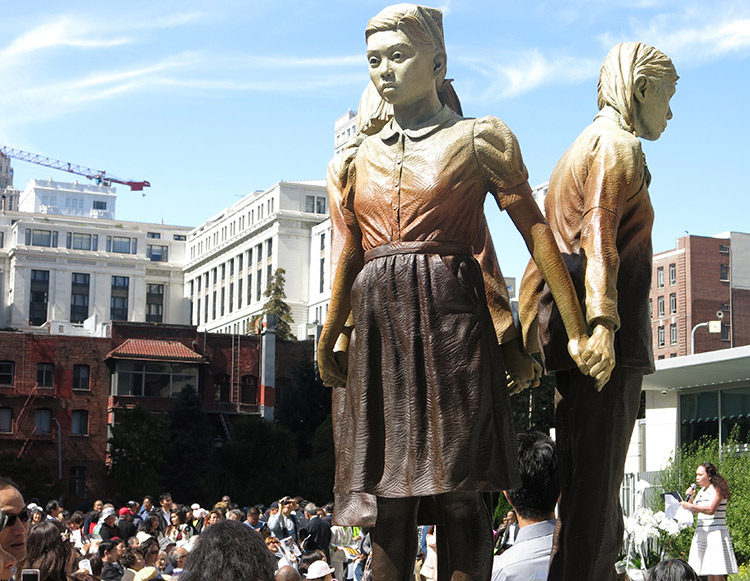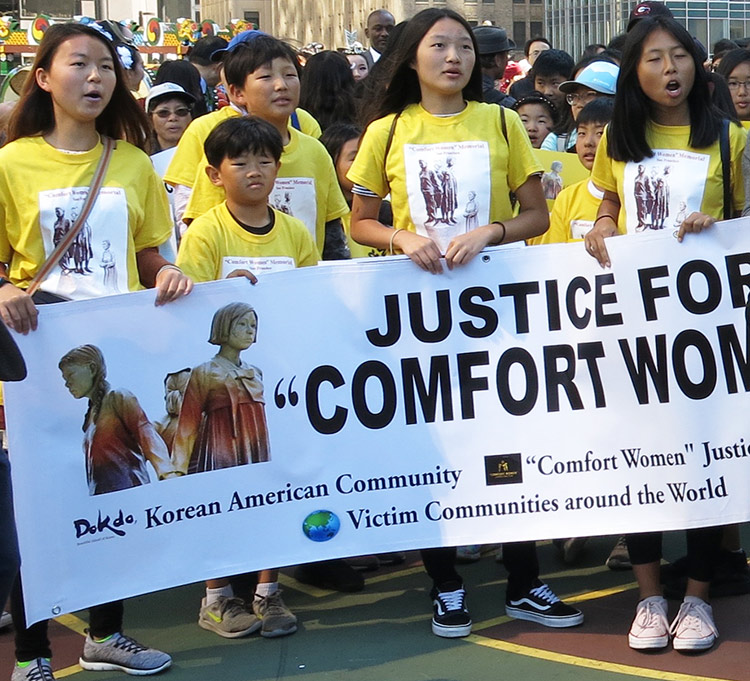SAN FRANCISCO — Nearly 500 people on Sept. 22 commemorated the first anniversary of the installation of a “comfort women” memorial here that has sparked a sharp controversy. The mayor of Osaka, Japan, recently terminated its six-decade sister-city relationship with San Francisco in retaliation for the memorial, reported the Oct. 3 San Francisco Examiner.
“Comfort women” is the euphemism employed by the Japanese government to describe the more than 200,000 women kidnapped and forced into brothels to service Japanese soldiers during World War II. Women who tried to resist or escape were badly beaten, even shot. The United Nations estimates that 90 percent of these women died during their captivity.
The Japanese monarchy seized Korea in 1905 and Japanese warlords imposed their political rule over land and labor. They invaded Manchuria in 1931 and occupied most of Pacific Asia. In every area Japanese imperialist forces occupied, they set up “comfort stations” where women were forced to service as many as 70 Japanese soldiers a day.
This was part of the Japanese rulers’ moves to challenge Washington in the Pacific, and to suppress and colonize the peoples they conquered. Millions were transported against their will to the Japanese mainland to serve as forced labor. Korean farmland was seized and turned over to Japanese landlords who moved there.
Koreans were ordered to speak Japanese, not Korean, and in 1939 to take Japanese names. This oppression was hated by the vast majority and rebellions and protests were drowned in blood.
Long after the U.S. rulers defeated Tokyo in the war, this sexual slavery organized by the Japanese government was covered up. Many of these women were barred by their native rulers and abandoned by the Japanese government. In fact, Japan’s surrender did not end the military brothels. Washington’s occupation forces allowed comfort stations to operate until 1946, servicing tens of thousands of U.S. soldiers.
Women speak out
Not until a courageous Korean woman, Kim Hak-soon, spoke out in 1991 to tell the truth and demand an apology and reparations from the Japanese government did hundreds of women in Korea, China, the Philippines and elsewhere begin to talk publicly about their experiences and fight for justice.
Finally in 2015, the rulers in Japan and South Korea struck a deal. Tokyo offered a vaguely worded “statement of regret” and a one-time contribution of 1 billion yen — then $8.3 million — to Seoul to set up a foundation to compensate some of the women who still survived.
In return, Seoul was to consider the comfort women issue to be “resolved finally and irreversibly,” in hopes it would fade away. The Korean government was also to remove the bronze statue of a comfort woman that had been installed in front of the Japanese Embassy in Seoul.
But those protesting the Japanese government’s treatment of the comfort women refused to keep quiet. Korean activists have put up more statues — in more than 50 parks and public spaces, and even on buses. Memorials to the comfort women have been erected in other Pacific nations, often under protest from the Japanese government.
The San Francisco statues were the eighth memorial erected in the United States, and more are planned.
Tokyo continues to deny that the Japanese military organized the comfort stations, insisting the women freely chose to be prostitutes. It also claims that Japan should not be singled out, since sexual violence against women has been part of wars throughout history. They go so far as to assert that holding the Japanese government accountable for this crime only serves to fuel anti-Japanese racism.
Seeking to rebuild imperialist army
Why is the Japanese government on a drive to prevent comfort women memorials? Simply put, their denial of the coercion of the comfort women is part of a larger campaign to strengthen support at home for Japanese capitalism against its competitors in Asia and elsewhere, and support for rebuilding the capitalist rulers’ military.
In 1947 Article 9, written by the occupying U.S. military commanders, was inserted in the Japanese Constitution. It states that “land, sea and air forces … will never be maintained. The right of belligerency of the state will not be recognized.”
The collective memory of the devastation suffered by Japanese workers and farmers at the hands of Japan’s military dictatorship during the second imperialist world war, and from Washington’s nuclear bombing of Hiroshima and Nagasaki, fuels the widespread opposition to rebuilding the military. A generation of workers and farmers was decimated. Millions were killed or wounded after being drafted to fight in Japanese imperialism’s invasion of Asia.
Japanese workers at home were also the target of U.S. imperialism. Washington aimed at civilians when it firebombed and bombed from the air or warships 66 Japanese cities, including killing over 80,000 in Tokyo alone. They destroyed over 2.3 million houses — 20 percent of all housing in Japan. Even U.S. Brig. Gen. Bonner Fellers called the firebombing “one of the most ruthless and barbaric killings of noncombatants in all history.”
As the deepening world economic crisis has unfolded, competition among the capitalist bosses and their governments has sharpened. The Japanese ruling class needs to turn its already massive Self-Defense Forces into an offensive power in order to assert its position, including in the Pacific. This is especially important to the Japanese bosses as Beijing expands its economic and military presence throughout the region.
However, they aren’t meeting with much success. The movement to tell the truth about the history of the oppression of the comfort women has been growing, even in Japan. In Tokyo, the Women’s Active Museum on War and Peace has compelling exhibits showcasing their testimony.
And in opposition to the stance of their mayor, a delegation of two grassroots groups from Osaka traveled to San Francisco in a show of solidarity supporting the memorial.
“We hope to continue to learn from you and grow together to cultivate solidarity and relationships,” Kazuko Yamahara of the Forum for Improvement of Osaka told the rally here, “so that we will continue to ensure that history stays alive through the next generation.”



